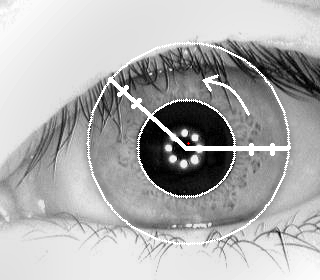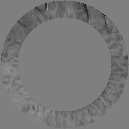 |
Hermite projection methods for human iris identificationElena Pavelyeva, Andrey Krylov Biometrical technologies are actively used in many areas to ensure information access protection and solve the problem of personal identification. One of personal identification methods is iris identification. 
The iris is a part of eye between the pupil and sclera. Iris recognition is a very reliable method of personal identification. The iris image is unique for each person and doesn’t change during the life. Human identification by iris recognition is more reasonable than by finger-print or face detection, because the iris image is more random than faces or fingerprints. So using iris recognition method is reasonable and is going to have great perspectives. In our work, Hermite projection methods are used for human iris identification. Expansion of iris intensity information into a series of eigenfunctions of the Fourier transform enables us to perform information analysis of the signal and its Fourier transform at the same time. Also these methods are robust to information errors. In our work, we present some preprocessing algorithms that refine the area for iris parametrization. Then we propose a hierarchical Hermite method Then we determine the owner of the most similar iris in the database using a hybrid algorithm. Effectiveness of the methods with test iris images database has been demonstrated in our work.
Publications2012Е. А. Павельева. «Метод проекционной фазовой корреляции в ключевых точках радужной оболочки глаза» // в: 22-я международная конференция по компьютерной графике и ее приложениям ГрафиКон'2012. Москва, 2012, с. 128−132. PDF. 2011Е. А. Павельева, А. С. Крылов. «Определение локальных сдвигов изображений радужных оболочек глаз методом проекционной фазовой корреляции» // в: 21-я международная конференция по компьютерной графике и зрению GraphiCon'2011. Москва, Россия, 2011, с. 188−191. PDF. Е. А. Павельева, А. С. Крылов. «Метод проекционной фазовой корреляции в задаче идентификации человека по радужной оболочке глаза» // в: Труды 13-й международной конференции «Цифровая обработка сигналов и её применение» (DSPA'2011), т. 2. Москва, 2011, с. 167−170. E. A. Pavelyeva, A. S. Krylov. “Projection phase only correlation method for iris recognition” // In: Proceedings of 13-th International Conference “Digital Signal Processing and its Applications” (DSPA'2011), Vol. 2. Moscow, Russia, 2011, p. 170. Е. А. Павельева, А. С. Крылов. «Алгоритм сравнения изображений радужной оболочки глаза на основе ключевых точек» // Информатика и её применения, т. 5, вып. 1, 2011, с. 68−72. PDF. 2010Е. А. Павельева, А. С. Крылов. «Поиск и анализ ключевых точек радужной оболочки глазаметодом преобразования Эрмита» // Информатика и её применения, т. 4, №. 1, 2010, с. 79−82. E. A. Pavelyeva, A. S. Krylov. “An Adaptive Algorithm of Iris Image Key Points Detection” // In: 20-th International Conference on Computer Graphics GraphiCon'2010. St. Petersburg, Russia, 2010, pp. 320−323. PDF. 2009Е. А. Павельева, А. С. Крылов. «Алгоритм идентификации человека по ключевым точкам радужной оболочки глаза» // в: 19-я международная конференция по компьютерной графике и ее приложениям ГрафиКон'2009. Москва, 2009, с. 228−231. PDF. Е. А. Павельева, А. С. Крылов, О. С. Ушмаев. «Развитие информационной технологии идентификации человека по радужной оболочке глаза на основе преобразования Эрмита» // Системы высокой доступности, №. 1, 2009, с. 36−42. PDF. 2008Е. Павельева, А. Крылов. «Алгоритмы предобработки изображений радужной оболочки глаза (Algorithms of iris image preprocessing)» // в: 18-я международная конференция по компьютерной графике и ее приложениям ГрафиКон'2008. Москва, 2008, с. 314. PDF. 2007A. S. Krylov, E. A. Pavelyeva. “Iris Data Parametrization by Hermite Projection Method” // In: 17-th International Conference on Computer Graphics GraphiCon'2007. 2007. PDF. A. Krylov, E. Pavelyeva. “Iris Data Parametrization by Hermite Projection Method” // In: 17-th International Conference on Computer Graphics GraphiCon'2007. Moscow, Russia, 2007, pp. 147−149. PDF. |
|



